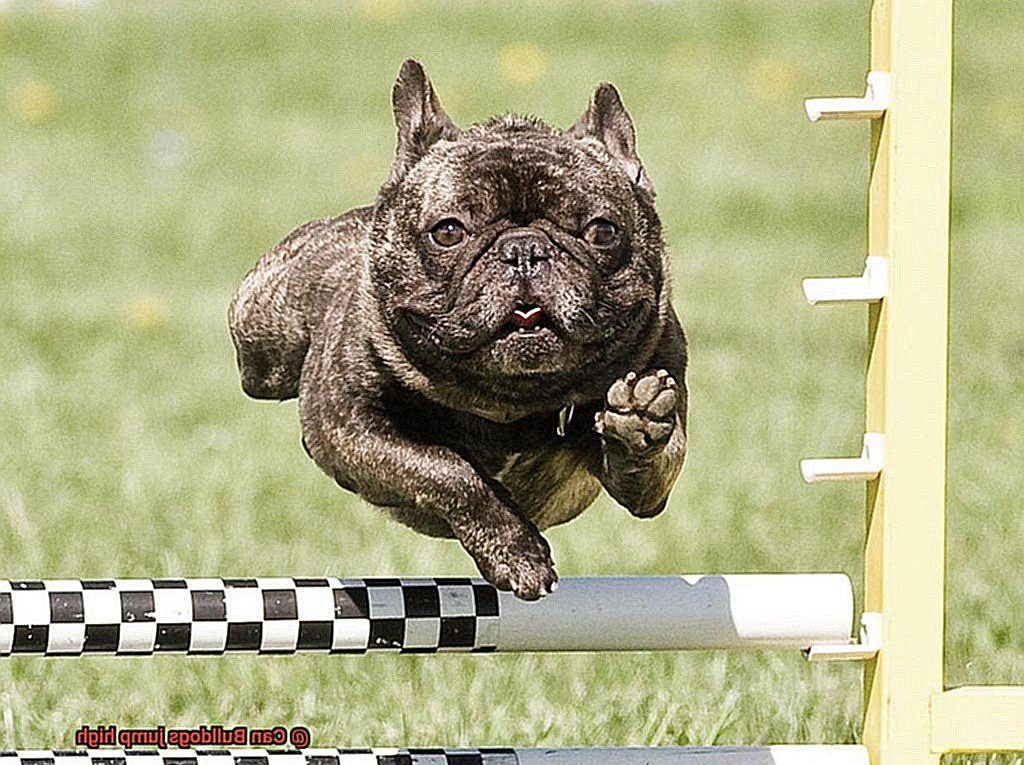Can Bulldogs jump high?
Bulldogs, with their adorable looks and lovable personalities, have won over the hearts of dog lovers worldwide. But there’s one burning question that keeps popping up in conversations about these charming canines: Can Bulldogs jump high? Well, let’s dive into the world of vertical agility to find out.
When it comes to soaring through the air with jaw-dropping heights, Bulldogs aren’t exactly known for their Olympic-level jumps. It’s not just a made-up rumor – their unique physical features play a significant role in their jumping abilities.
To understand why Bulldogs aren’t high-flying acrobats, we need to take a closer look at their body structure. Bulldogs have sturdy muscles packed into their compact bodies, built for strength and endurance rather than gravity-defying stunts. Their strong heads, deep chests, and solid bones give them incredible power but make it tough for them to reach impressive heights.
On top of that, Bulldogs have a higher center of gravity due to their stocky build and distinctive body shape. With short legs, broad shoulders, and big torsos, they face extra challenges when it comes to executing those breathtaking leaps.
And let’s not forget about their unique skull shape. Bulldogs have what’s called a brachycephalic skull – think shortened noses and restricted airways. While this adorable feature gives them that unmistakable squishy face we all love, it also affects their athletic performance by making it harder for them to breathe during intense activities.
But hey, just because Bulldogs might not be jumping champions doesn’t mean they’re any less amazing as companions. Their gentle nature, loyalty, and endless devotion make them perfect family pets. Plus, they always know how to bring joy with their playful antics.
In our upcoming exploration of Bulldog jumping abilities, we’ll delve deeper into their anatomy and uncover any exceptions or rare moments where Bulldogs manage to defy gravity. So stay tuned as we unravel the secrets behind Bulldogs’ jumping capabilities and gain a better understanding of these beloved pups’ incredible qualities.
Anatomy of a Bulldog: Understanding Their Limitations
Contents
- 1 Anatomy of a Bulldog: Understanding Their Limitations
- 2 Factors Influencing Bulldogs’ Jumping Abilities
- 3 How High Can Bulldogs Jump?
- 4 Risks Associated with Excessive Jumping
- 5 Alternatives to Encourage Exercise without Jumping
- 6 Tips for Improving Your Bulldog’s Jumping Skills
- 7 Professional Guidance on Managing Your Bulldog’s Jumping Abilities
- 8 Conclusion
Bulldogs are beloved for their unique appearance and lovable personalities. However, their anatomy can pose limitations when it comes to certain activities, such as jumping. In this article, we will explore the anatomy of Bulldogs and how it affects their jumping abilities, specifically targeting French Bulldog owners.
Body Structure: Short Legs and Stocky Build
One key aspect of a Bulldog’s anatomy that affects their jumping ability is their body structure. Bulldogs have a heavy and muscular build with short legs. This compact stature makes it challenging for them to generate the power and momentum required for high jumps. Unlike other breeds known for their agility, Bulldogs struggle to achieve the height and agility needed for impressive leaps.
Brachycephalic Skull Shape: Breathing Difficulties
Another factor to consider is the Bulldog’s brachycephalic skull shape. Bulldogs have flat faces with shortened snouts, which can lead to respiratory issues. Due to their narrowed airways, Bulldogs often struggle with breathing difficulties. This compromised airflow can limit their physical exertion and stamina, making it harder for them to jump or engage in strenuous activities.
Weight Distribution and Short Neck
Additionally, Bulldogs have a relatively heavy head compared to the rest of their body. This weight distribution can affect their balance and coordination, making it more challenging for them to execute precise jumps. Their short necks also restrict their range of motion, further hindering their ability to jump high or engage in activities that require significant neck extension.
Limitations in Jumping Height
It is important to understand that Bulldogs, including French Bulldogs, are not known for their jumping abilities. Their stocky build, short legs, brachycephalic skull shape, weight distribution, and short necks all contribute to these limitations. While individual Bulldogs may vary in their jumping capabilities depending on factors like age and fitness level, it is generally unrealistic to expect Bulldogs to clear high obstacles or engage in activities that require extensive jumping.
Alternative Options and Responsible Ownership
As responsible pet owners, it is essential to provide an environment that accommodates Bulldogs’ needs and prevents them from engaging in activities that could potentially harm them. If you have concerns about your Bulldog’s jumping abilities or need to create an environment that discourages jumping, consider alternative options such as using ramps or stairs instead of expecting them to jump onto furniture or into vehicles. Regular exercise and mental stimulation through activities like obedience training or puzzle toys can also keep Bulldogs physically and mentally stimulated without relying on excessive jumping.
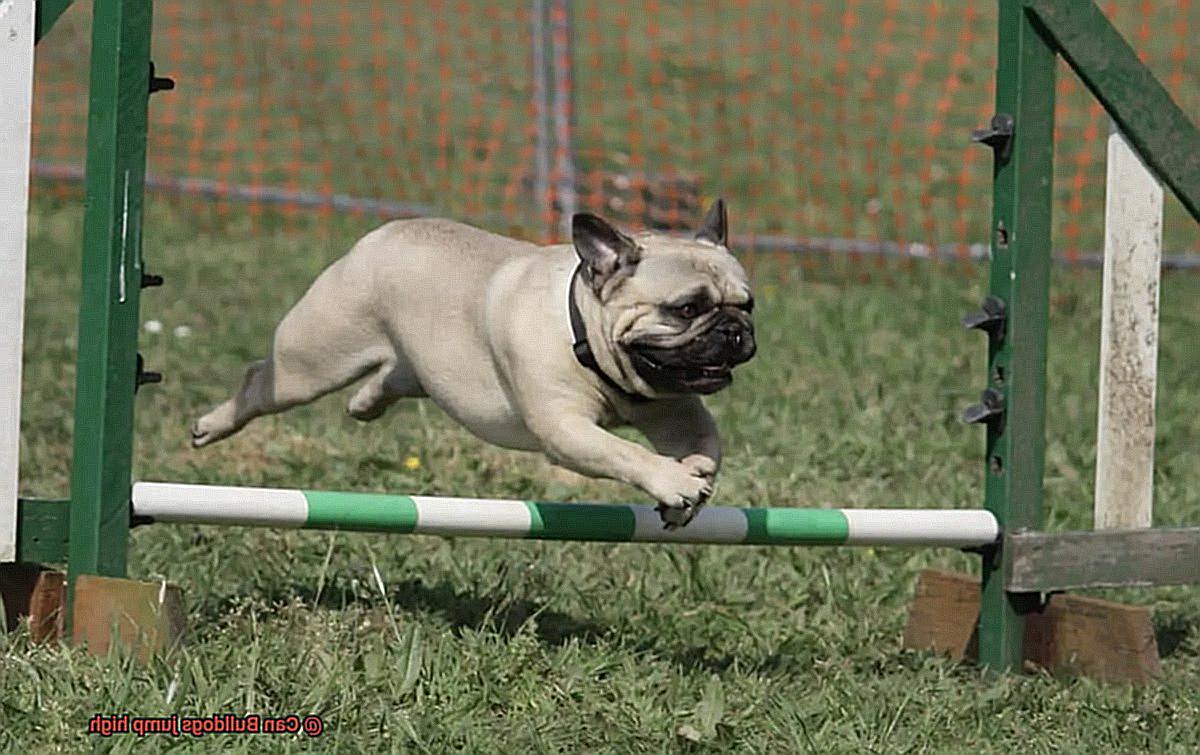
Consulting with a veterinarian or a professional dog trainer who specializes in Bulldogs can provide valuable insights and guidance on managing your Bulldog’s jumping abilities or limitations. It is important to prioritize their health and well-being while still providing opportunities for them to enjoy physical activity within their limitations.
Factors Influencing Bulldogs’ Jumping Abilities
We all know how much our adorable fur babies love to explore and play. But have you ever wondered why your bulldog can’t quite reach those high jumps like other dogs? Well, today we’re going to dive into the factors that influence our bulldogs’ jumping abilities and explore some ways to help them stay active and happy.
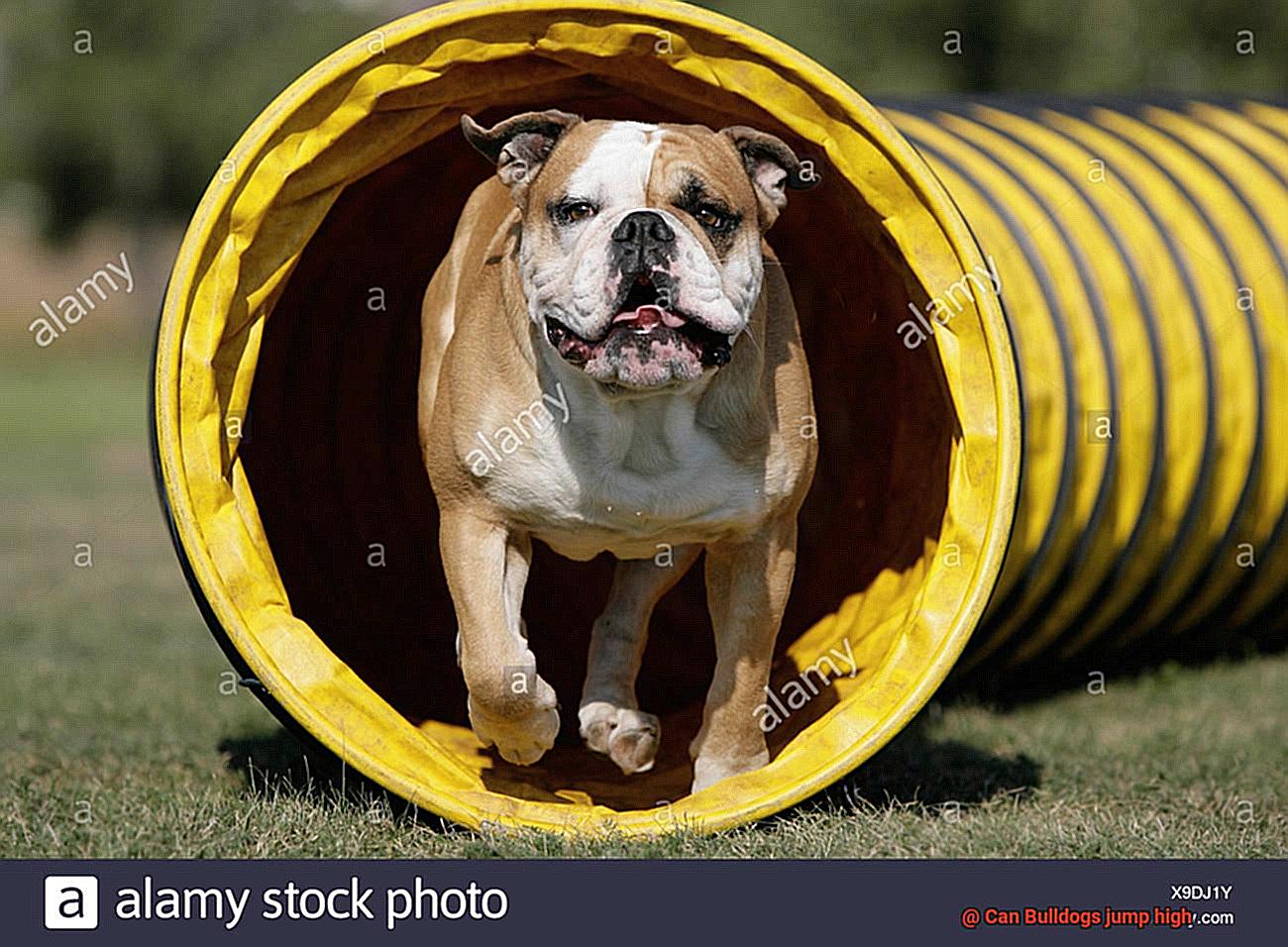
Anatomy and Body Structure:
Let’s face it, our bulldogs have a unique physique that sets them apart. Their stocky build and compact bodies make it challenging for them to achieve impressive heights in jumps. Bulldogs’ heavy bone structure and low center of gravity limit their power and momentum, hindering their ability to jump high.
Breathing Difficulties:
It’s no secret that bulldogs are brachycephalic breeds, characterized by their short snouts and flat faces. While these features give them their signature cuteness, they also come with respiratory challenges.
Bulldogs may struggle to breathe properly during physical activities like jumping due to their compromised airways. It’s essential to be mindful of their breathing limitations while engaging in any strenuous activities.
Joint and Muscle Strength:
Bulldogs are not known for having the strongest joints and muscles compared to other dog breeds. This weakness can affect their ability to jump higher as they may lack the necessary strength and flexibility. Regular exercise and maintaining a healthy weight can help strengthen their muscles and improve their jumping abilities.
Age and Health:
Just like humans, age can take a toll on our bulldogs’ joints and overall health. As they age, joint issues such as arthritis can limit their mobility and jumping capabilities.
Additionally, certain health conditions or injuries, such as hip dysplasia or spinal problems, can cause pain and discomfort, making it difficult for them to perform high jumps. Regular vet check-ups and appropriate care are crucial to ensure their well-being.
Training and Conditioning:
While bulldogs may not be natural athletes, they can still improve their jumping abilities with the right training and conditioning. Incorporating activities like agility training, strength-building exercises, and jump training into their routine can help them develop better techniques and increase their jumping heights.
Remember to start small and gradually increase the difficulty to avoid any unnecessary strain.
Conclusion:
Understanding the factors that influence our bulldogs’ jumping abilities helps us set realistic expectations and provide appropriate care for our furry friends. While they may not soar through the air like some other breeds, they still deserve engaging activities that keep them mentally stimulated and physically active.
So, let’s embrace their unique qualities, work within their limitations, and continue showering them with love and affection.
Remember, always consult with your veterinarian before starting any new exercise regimen or if you have concerns about your bulldog’s health or mobility.
How High Can Bulldogs Jump?
Unleashing the Truth Behind their Vertical Leaps.
Physical Structure: The Hulk or The Rock?
When it comes to jumping, Bulldogs have a few physical limitations working against them. Their heavy and compact bodies, combined with a low center of gravity, make it challenging for them to generate the explosive power needed for high jumps.
Their short legs and broad chests also play a role in limiting their vertical leap. So, while Bulldogs may not be able to rival Olympic high jumpers, they can still surprise you with their agility.
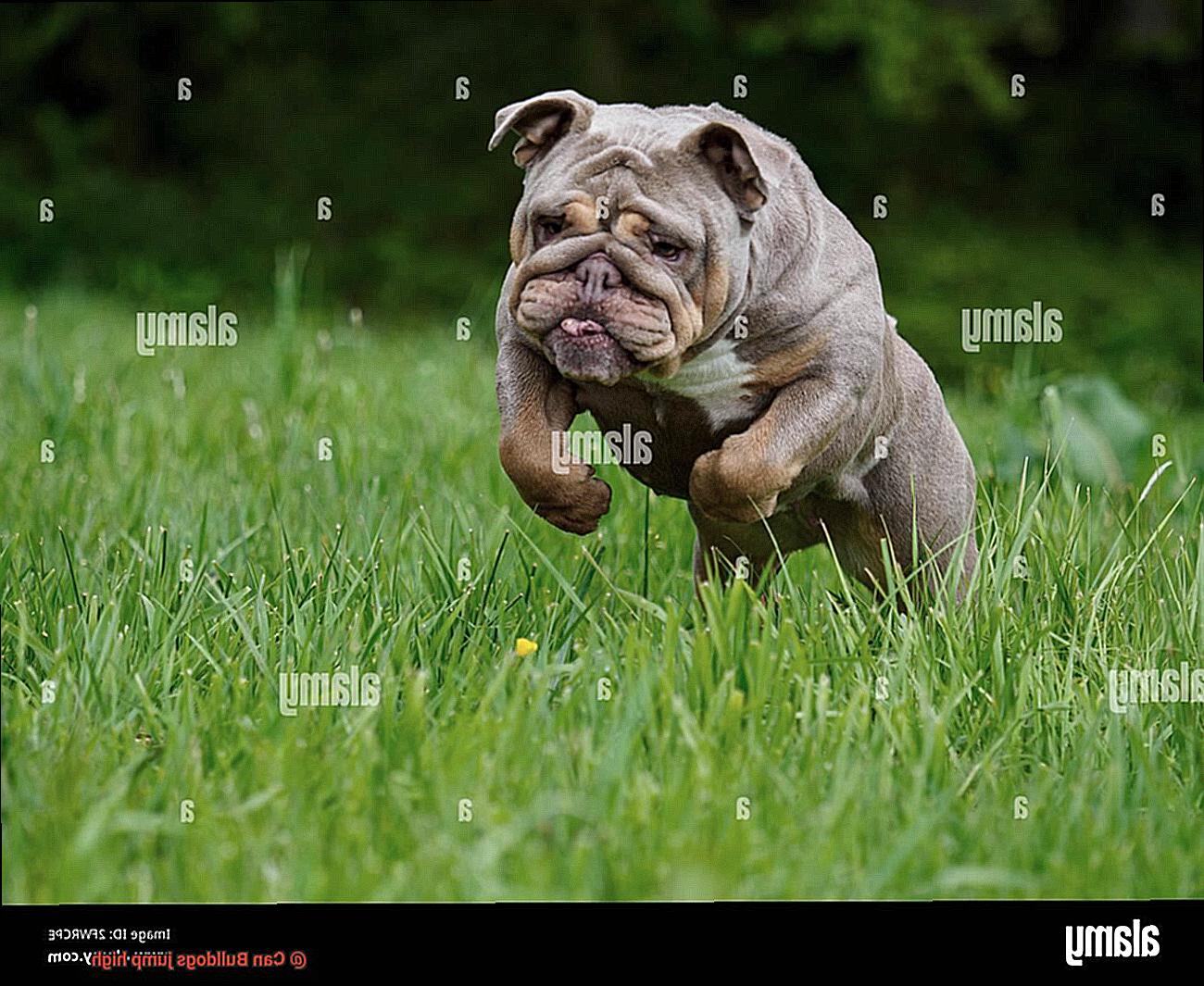
Bulldog Breed Characteristics: A Breath of Fresh Air or Gasping for Breath?
Bulldogs are brachycephalic dogs, meaning they have short and flat muzzles. This unique facial structure can lead to respiratory issues and difficulty breathing during physical exertion. Consequently, Bulldogs may not have the stamina or lung capacity required for sustained jumping activities. It’s important to keep an eye on their breathing and avoid overexertion to prevent any discomfort or health complications.
The Personal Touch: Not All Bulldogs Are Created Equal
Just like people, Bulldogs have their own individual abilities and strengths. Some Bulldogs may possess more athleticism than others, surprising you with slightly higher jumps. Factors such as age, health condition, and training can also influence a Bulldog’s jumping capabilities. So keep an open mind and give your Bulldog a chance to show off their skills.
Safety First: Protecting Your Bulldog’s Well-being
While it’s tempting to see your Bulldog reach new heights in their jumping adventures, it’s crucial to prioritize their health and well-being. Given their physical limitations and potential respiratory issues, it’s best to avoid subjecting Bulldogs to excessive or strenuous jumping exercises. Instead, focus on providing them with regular exercise routines tailored to their specific needs, such as walks or moderate play sessions. Remember, a happy and healthy Bulldog is the ultimate goal.
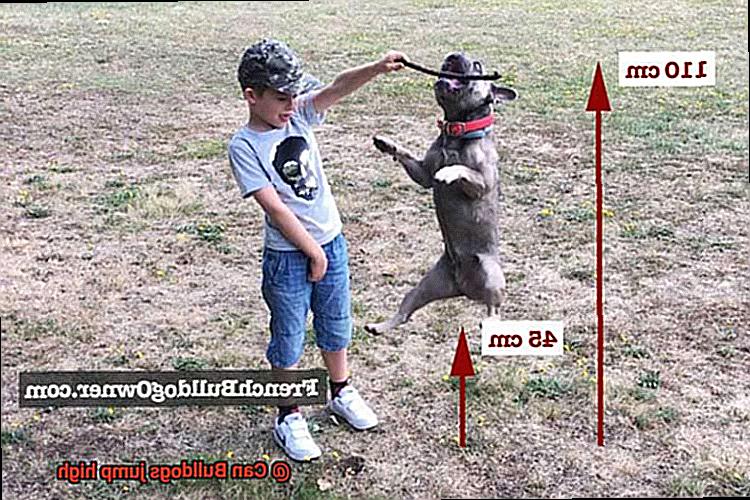
Risks Associated with Excessive Jumping
Jumping may not be a natural talent for Bulldogs, but some of these adorable pups can surprise you with their hops. While it’s tempting to cheer them on and marvel at their acrobatics, it’s crucial to understand the risks that excessive jumping can pose to their health.
So, let’s dive into the potential dangers and how we can keep our Bulldogs safe and sound.
Joint and Bone Injuries
Bulldogs are already prone to orthopedic issues like hip dysplasia and patellar luxation. Excessive jumping can worsen these conditions and cause pain and discomfort for our furry friends.
Spinal Problems
Jumping puts stress on a Bulldog’s spine, increasing the risk of disc herniation or compression. This can lead to excruciating pain, nerve damage, and even paralysis.
Soft Tissue Injuries
With their low muscle mass, Bulldogs may struggle to land properly after a jump, increasing the likelihood of muscle or ligament strains and sprains.
Respiratory Strain
Bulldogs’ adorable squishy faces make breathing challenging for them. Activities that require increased exertion, like jumping, can further strain their respiratory system and potentially lead to breathing difficulties or overheating.
Now that we know the risks, how can we keep our Bulldogs safe?
- Provide low-impact exercise alternatives like gentle walks or swimming.
- Monitor playtime and discourage jumping on furniture or stairs.
- Be vigilant for signs of joint pain or discomfort after jumping and seek veterinary attention promptly.
- Consider using ramps or steps to minimize the impact of jumping onto beds or couches.
Alternatives to Encourage Exercise without Jumping
As proud French Bulldog owners, we know that our precious pups may not be the best jumpers. But that doesn’t mean they can’t stay active and fit. In fact, there are plenty of alternatives to jumping that can help encourage exercise without putting unnecessary strain on their bodies. So let’s explore some fun and effective ways to keep our Frenchies active and healthy.
- Take leisurely walks: French Bulldogs may not be built for high jumps, but they can certainly enjoy a nice stroll. Regular walks provide both physical exercise and mental stimulation for your Frenchie as they get to sniff and explore the world around them. Make sure to choose suitable walking routes that are flat and free from obstacles to avoid any potential injuries.
- Dive into swimming: Did you know that French Bulldogs are naturally buoyant? That’s right. Their dense bodies and broad chests make them excellent swimmers. Swimming is a fantastic low-impact exercise that engages your Frenchie’s entire body, helping to build muscle strength, improve cardiovascular health, and manage weight. Just remember to introduce your Frenchie to water gradually and ensure their safety at all times.
- Get interactive with toys and puzzles: French Bulldogs have a strong prey drive, so engaging them in mentally stimulating activities is a great way to burn off energy. Invest in puzzle toys that require your Frenchie to solve problems or retrieve treats. These toys keep them mentally engaged while providing some physical activity. Additionally, playing fetch with soft toys or balls can be a fun way to encourage running and chasing without the need for jumping.
- Try physical therapy exercises: If your Frenchie has limited mobility or health issues that restrict high-impact exercises, physical therapy exercises can be beneficial. Consult with a veterinarian or a professional canine physical therapist to develop a customized exercise plan that focuses on improving range of motion, strengthening muscles, and promoting overall mobility.
- Engage in obedience or agility training: Training sessions not only provide mental stimulation but also keep your Frenchie physically active. Obedience training helps enhance their bond with you and improves their overall behavior. While jumping may be a part of agility training, there are modified courses available specifically designed for Bulldogs and other breeds with low jumping abilities.
Tips for Improving Your Bulldog’s Jumping Skills
When it comes to jumping, Bulldogs are not known for their high-flying skills. Their stocky and muscular build, combined with a low center of gravity, makes it challenging for them to achieve impressive heights. Unlike breeds like Border Collies or Jack Russell Terriers, Bulldogs have short legs and heavy bodies that limit their jumping abilities.
The anatomy of Bulldogs also plays a role in their restricted jumping capabilities. With their large heads and compact bodies, they face balance and coordination challenges. Their broad chests and short necks further restrict their range of motion. While Bulldogs may still be capable of some level of jumping, it is typically not very high. They may be able to clear small obstacles like low fences or shorter distances with some effort.
It’s important to note that individual Bulldogs may vary in their jumping abilities. Factors such as age, fitness level, and overall health can influence their performance. Younger and more active Bulldogs may have slightly better jumping capabilities than older or less active ones.
However, due to their unique body structure, Bulldogs are prone to joint and spine issues. Jumping can put strain on these areas, potentially leading to injuries or exacerbating existing health conditions. It’s crucial to monitor your Bulldog’s jumping activities and take measures to prevent any harm.
If you have concerns about your Bulldog’s jumping abilities or want to create an environment that discourages jumping, there are alternative options to consider. For example, using ramps or stairs instead of expecting them to jump onto furniture or into vehicles can help minimize stress on their bodies.
Engaging in regular exercise and providing mental stimulation through activities like obedience training or puzzle toys can keep Bulldogs physically and mentally stimulated without relying on excessive jumping.
Consulting with a veterinarian or a professional dog trainer who specializes in Bulldogs can provide valuable insights and guidance on managing your Bulldog’s jumping abilities or limitations.
Professional Guidance on Managing Your Bulldog’s Jumping Abilities
Bulldogs may not be known for their jumping prowess, but that doesn’t mean they won’t attempt to jump or have the potential to injure themselves. As a responsible Bulldog owner, it’s essential to manage and control their jumping tendencies to keep them safe and happy. In this article, we’ll explore effective strategies for managing your Bulldog’s jumping abilities through training, reward systems, environmental management, and mental/physical stimulation.
Training and Obedience:
- Teach your Bulldog basic commands like “sit” or “stay” to redirect their energy and prevent excessive jumping.
- Consistently reinforce these commands during everyday interactions to establish obedience and reduce jumping behaviors.
- Use positive reinforcement techniques, such as treats or praise, to reward your Bulldog for calm behavior.
Reward Systems:
- Reinforce calmness by rewarding your Bulldog when they exhibit calm behavior instead of jumping.
- Ignore or redirect jumping behavior without giving it attention, as this can inadvertently encourage the behavior.
- Encourage alternative behaviors like sitting or lying down by rewarding and praising your Bulldog whenever they choose those options instead of jumping.
Environmental Management:
- Remove potential hazards that may encourage jumping, such as objects on countertops or tables that are within reach.
- Secure fences or gates to prevent escape attempts, ensuring your Bulldog remains safe within the confines of your property.
- Provide comfortable resting areas at an appropriate height for easy access, discouraging the need for jumping onto furniture.
Mental and Physical Stimulation:
- Engage in regular exercise sessions tailored to your Bulldog’s needs, such as walks or playtime in a secure area.
- Provide mentally stimulating activities like puzzle toys or treat-dispensing toys to keep your Bulldog entertained and reduce pent-up energy.
- Consider enrolling your Bulldog in agility training or canine sports that focus on controlled jumping exercises.
Seeking Professional Help:
- If your Bulldog’s jumping behavior persists despite your efforts, consult a professional dog trainer or behaviorist.
- A professional can assess your Bulldog’s specific needs and provide personalized guidance to address any behavioral issues.
w7mVp0UVAtw” >
Conclusion
In conclusion, Bulldogs are not known for their jumping abilities.
Due to their unique body structure and heavy build, Bulldogs are not built for high jumps. Their short legs and muscular bodies make it difficult for them to achieve significant height when jumping.
While Bulldogs may be able to jump small obstacles or onto low surfaces, they are not capable of impressive leaps or acrobatic feats like some other breeds. It’s important for Bulldog owners to be mindful of this limitation and ensure their pets’ environments are safe and suitable for their physical abilities.
So, if you’re looking for a dog that can soar through the air with grace and agility, the Bulldog may not be the best choice.
